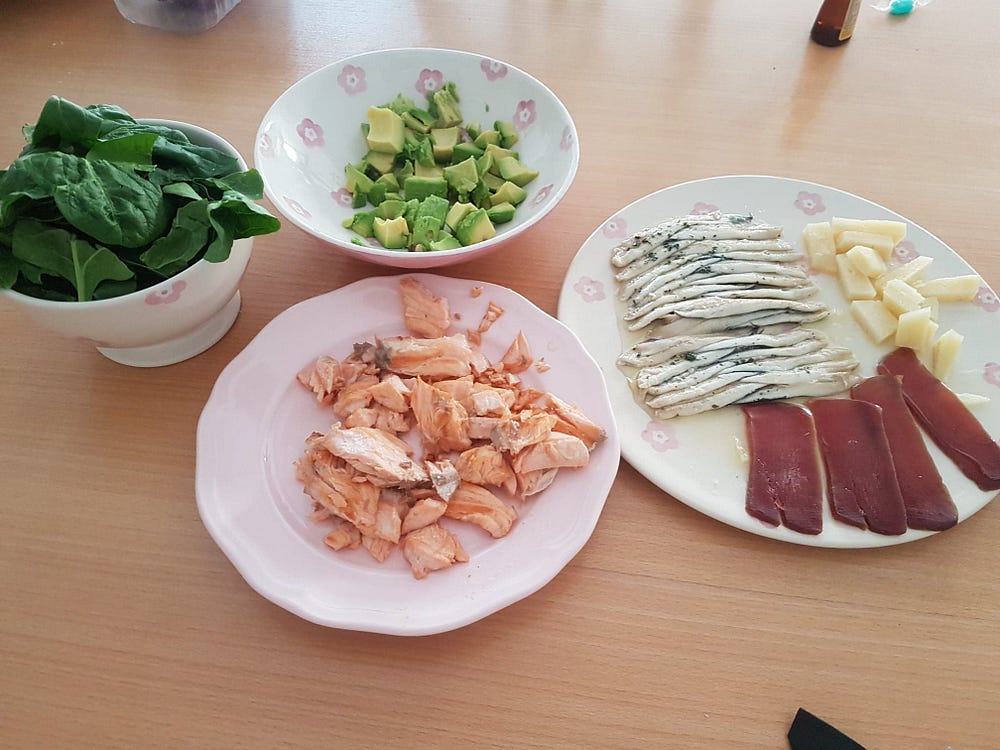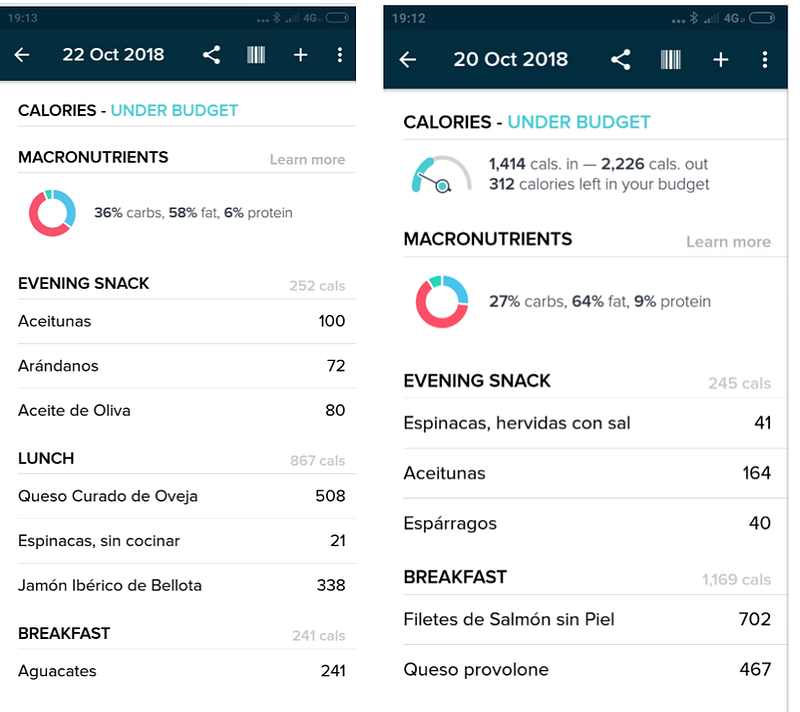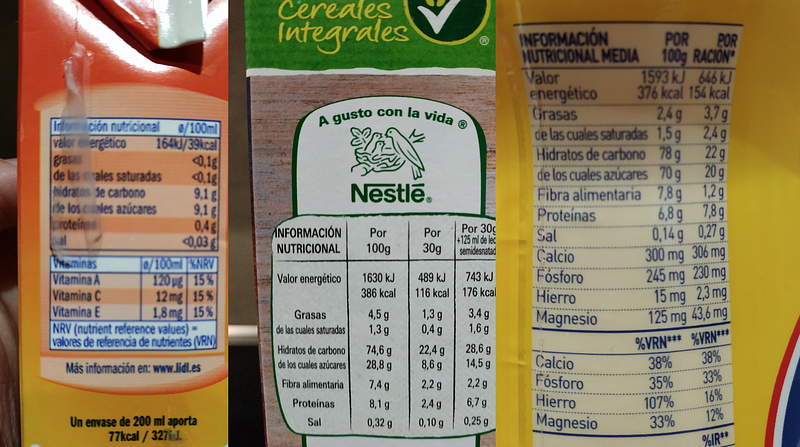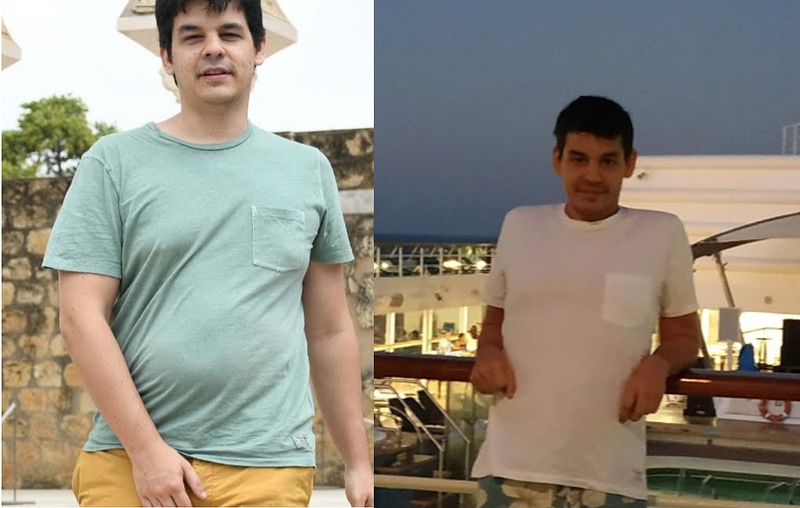Part 2: My 4 month journey about Keto diet with Intermittent Fasting (OMAD)
If you did not read part 1 of my journey to weight loss with Keto diet with Intermittent Fasting OMAD: You can always go back with this link and read it: Part 1

My food pyramid of the future
I completely eliminated bread, rice, pasta, potatoes, cereals, cookies, etc.
I ate a ton of salmon, tuna, olives, avocados, spinach, shellfish and cheese.
A ton means that my normal meal would be 400 grams of Salmon, fried (that's a lot of salmon, but I wanted to feel satisfied). 120 grams of spinach (that's a ton of spinach too). A lot of olives (easily 150 grams of olives) or 1 avocado. Cheese to give flavor to my salmon salad. And olive oil, around a large spoon (a spoon is 15 grams, so that's 140 calories in olive oil alone).
So basically, my only source of carbs was spinach. I barely ate fruits either. Bananas and pineapples have a lot of sugar. However I did eat blueberries some times (they have the lowest sugar %).
Again, I would eat so much of this stuff that I could simply not eat any more.
I did not eat dairies either. Most yogurts have very high amounts of sugars. Those with "low fat" are the worst. You should also reconsider your approach to low fat milk. If you want milk… consider the normal fat variety.
When in restaurants, I ordered fish and would remove the sauce. The good thing about fish is that you know what you are eating. With sauces you don't. If we went to a burger restaurant, order the burger with cheese and bacon but not eat the bun or the fries. In a japanese restaurant, sashimi. In an italian restaurant, whatever chicken parmiggiano they had without pasta.
My favourite keto friendly foods are:
- Salmon and Tuna. By a mile. Mostly Cooked, often raw, sometimes canned when necessary.
- Olives or Avocados. In Spain, Olives are way cheaper and easier to buy. Instead of eating meats with salads or fries, my garnish was just olives. Avocados are just as good but more expensive and they require more effort to be cut and eaten. So olives it was. Of all sizes and flavors.
- Seafood, like Octopus, easy to access too, even if the canned variety was not as healthy, sometimes this was the only protein available, or Shrimp. Super good protein
- Spinach. I just like it better than Kale or any other green. I eat them uncooked, as a salad. Cooked, I ate a lot of peas with ham.
- Iberico Ham. The most delicious food in the world is allowed in this diet.
- Cheeses of all sorts. It's not like the best kind of fat, but you know, when you are making this level of effort, I wanted to give myself food I enjoy.
A picture of my most common meal of the last year, where I only had to cook salmon for about 10 minutes.

While it might sound like a very restrictive diet, many delicious foods are fatty, so I was quite happy with that.
The main misconceptions I had about food in the past had to do with starches. I have always understood that Coke or Chocolates or Pizza was "not eating healthy". At the same time my whole life I have considered that eating rice was "healthy" and I felt good about my healthy effort that day. But rice is all carbs, and with a very high glucemic index which spikes insulin. The same with corn or pasta or potatoes. This misconception has dragged me for a long time. I am sure that many people consider many of their meals to be healthy when they probably are not.
My pyramid above is not perfect for Keto, by the way. Keto does not recommend fruits, or dairies, or lentils. But I think that's an exaggeration. If you can get rid of the bottom part of the pyramid you are doing great. Eat whole foods, foods where you know exactly what you are eating, and you are 90% there. Also, put olive oil at the bottom of the pyramid instead of the top. Make it a key part of your daily diet.
Also, because I am eating only once and not eating snacks, I spent less money on food, so I could buy more "high quality more expensive foods" like red tuna.

These are typical days I logged. Don't pay attention to the evening snack, breakfast, or lunch tags. It was all just lunch in a single meal, I just did not log it properly. Also, I think the 27% carbs % is probably a bug in the Fitbit app and it was 27% protein, because I ate a lot of salmon that day. Olives, cheese, salmon, avocados, ham, spinach and blueberries. Blueberries is the fruit with less sugar, and it has vitamin E so it's ok.
Results:
- Over 4 months, I lost 15Kg. Of those, 2kg were of water (glycogen), 11 kg of fat and 1.5kg of muscle (it's almost impossible to bulk while you are in a 1000 calories per day deficit).
- My body fat has gone down from +25% to less than 16%. This is before doing any serious exercise as explained.
- I have gone from the Obese region to Overweight to Normal in BMI.
- My metabolic age (this is measured by a machine from my nutritionist) went down from 45 years old to 27 years old.
- We got pregnant :), which I cannot associate to keto or fasting, but I am happy to have passed epigenetics with a lower body fat.
Long Term Lifestyle:
It's not reasonable to think that I will not eat Paellas in the future, or potatoes or bread. I love bread. But now I have a protocol I can follow with consistency.
My objective for the coming years is to do OMAD at least 2–3 days a week, and Keto whenever possible, but without affecting what other people might want to eat (family, events, etc).
I might also go into 3–4 day fasting periods once or twice a year in fasting camps to boost autophagy.
Even on days I don't do OMAD, I have completely eliminated breakfast and snacks.
Problems and Challenges:
The problem of Keto is that you need to be many days on keto in order to adapt. This requires a level of consistency, but it's not really that hard.
Dinners with friends. You will not be able to keep OMAD every day. Those days you might want to just skip the fasting but maintain keto, or not have your lunch.
There is very little literature about keto in long term studies. Eliminating carbs might have some long term risks that we are not aware of today.
My sister is a doctor and thinks that keto cant be healthy. She did not give me any reasons for that, other than we release acetone as part of the fat burning. She promised to do some research to find the weaknesses but I am still waiting.
Factoid 1: Burning food
When you "burn fat", do you know where that fat goes? Most people seem to think you "poo" the weight, or the fats "turn into energy" or plasm or something. Both are wrong.
- Poo is just a % of the food that enters the tube and leaves the tube. It also has about 5–10% of biomass from gut bacteria but that's about it. There is no "fat that you are burning".
- Similarly, fat molecules does not just "burn" into "energy". We are not nuclear plants that destroy atoms. The principle of mass conservation remains in your body. The atoms need to leave.
When you burn fat it turns into H20 and CO2. Forget the H20 for a moment because there are too many things that come and go in the form of water inside and outside your body (pee, poo, sweat) and follow the CO2. When you breath in O2 and you release CO2, you are eliminating the Carbon atoms from your body, about 40 mg of CO2 per breath. A molecule of fat (triglyceride) is C55H98H6, so 55 atoms of Carbon. Do the math to know how many times you have to breath out your fat to lose weight :).
Factoid 2: Sugar
1 gram of sugar is 4 calories.
1 desert spoon is about 4 grams of sugar or a sugar cube.
Let's look at some labels of "healthy foods":

One day these will be forbidden. Colacao, the Spanish "breakfast for champions" that sponsors the Spanish olympic team is 70% sugar. Nestle healthy cereal are mostly sugar. The children juice advertised as "no fat" is mostly sugar. Those 9 grams of sugar per 100ml mean 18g of sugar in that tiny juice box, which, divided by 4, means about diluting 4.5 spoons of sugar to start the day. I took these pictures before tossing those foods.

A final picture to help illustrate. Left is from summer 2018; Right is December 2018. And that’s it. I hope this is useful to someone. Happy 2019!
Remember to Read part 1: Forgive me because this was a long post and could not fit in one page or as one article. Here is the link
Ready to take the next step in mastering your arousal and Cure your Premature Ejaculation? 👇
Get Your Copy of Mastering Your ArousalUnlock lasting control and confidence in your intimate life.
Related Posts
Trending Articles
Search Now
Recent Posts
- Understanding and Controlling Involuntary Kegels (Contractions) During Sex
- Why the Transition to Sex Can Be So Challenging After Premature Ejaculation Training?
- Why Setbacks Happen: The Truth About Orgasm During Your PE Recovery Journey
- I Prematurely Ejaculated in my Girlfriend while Trying to cure my premature ejaculation using the Guide
- Have you tried this technique once you get too close to PONR
Categories
- Premature Ejaculation
- Question & Answer
- Diseases
- Drugs
- Loans
- Insurance
- Health
- Hospital
- Lifestyle
- News
- Know How
- Education
- Travel
Comments (0)
Leave a Comment